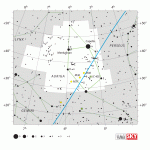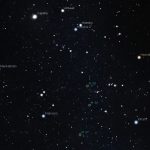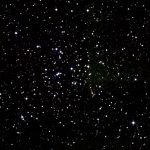| Meaning: | The Charioteer | Print out the star map from Sky and Telescope
Things to look for: Messier objects: Note: [x.x] indicates visual magnitude |
|
| Pronunciation: | or eye’ guh | ||
| Associated Asterisms: | The Kids, the Winter Oval, the Winter Hexagon | ||
| % of the sky: | 1.59% | ||
| Visible Stars: | 47 stars brighter than magnitude 5.5 |


Auriga is quite high in the sky although not enough to be fully circumpolar from UK latitudes; however, its brightest star Capella is circumpolar and visible throughout the year. It is a bright star and often one of the first to be seen whilst trying to orientate yourself with the night sky. As outlined with Taurus, El Nath, β Tau, used to be a star shared between Auriga and Taurus and is even shown as such in many line drawings of the constellation. It was that famous 1928 meeting of the IAU that removed it from Auriga and γ Aur ceased to exist.


Auriga is easiest found by finding Capella first and that is simply by following the top two stars of Ursa Major’s saucepan, Megrez and Dubhe, to the west. Auriga is the charioteer and there are several explanations for the it. Perhaps it is Greek hero Erichthonius of Athens, raised by the goddess Athena who invented the quadriga, the four-horse chariot or perhaps it is Myrtilus, who was Hermes’s son and the charioteer of Oenomaus. Myrtilus’s chariot was destroyed in a race intended for suitors to win the heart of Oenomaus’s daughter Hippodamia. Myrtilus earned his position in the sky when Hippodamia’s successful suitor, Pelops, killed him, despite his complicity in helping Pelops win her hand. Given there is no chariot in the constellation picture then perhaps Myrtilus fits the bill better.


ε Aur is an eclipsing binary with a period of 27 years. It goes dim for a year and then returns to full brightness; the drop is from mag 3.0 to 3.8 which is a halving of visual brightness. The exact cause is open to debate but could be a cloud of pre-stellar material co-orbiting the star.
There are three Messier objects within the bounds of the constellation. All are Open Clusters of varying brightness visible in binoculars. They are M36, M37 and M38. This density relates to Auriga sitting in the band of the Milky Way.



